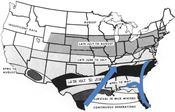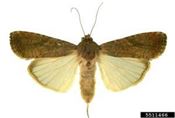Don’t Lose Sleep Over Fall Armyworms
DR. JONATHAN L. LARSON
PRINCETON, KENTUCKY
Last year, Kentucky was one of the many states impacted by a historic outbreak of fall armyworms. Much of the eastern U.S. was eaten up by these hungry, hungry caterpillars with lawns and fields on the menu.
While things eventually settled down and areas have been renovated, you can sense tension in the air this year with many wondering if it will happen again. The short answer is that we (UK entomologists) do not anticipate 2022 featuring the same level of pest pressure as last year. That being said, there are reasons to keep your eyes and ears open to see if things change.
Fall Armyworm & Kentucky
Fall armyworm does not overwinter in this state. Its usual winter hangouts are in southern Florida and southern Texas. These spots stay warm enough for them to persist and then mate to start the generations that will migrate northward. They usually move from these areas into states like Mississippi and Alabama in April and May, arriving next in Tennessee by May or June. Typically, they start to appear in Kentucky by June.
UK entomologists trap for pests like the fall armyworm using pheromone traps in Princeton and Lexington to help us track their arrival. In 2020 the first captures occurred June 14. In 2021, our first indicator that something would be amiss was that adults were first captured May 7, over a month earlier than usual. As of June 7, 2022, we have not yet captured migrating adult fall armyworms in Princeton or Lexington.
So, there won’t be any problems?
Because of the lack of adults here, we feel that this year should be more normal when compared to last year. We checked in with Dr. Katelyn Kesheimer of Auburn University about fall armyworm pressure there and she shared a photo of an egg mass taken last week (June 7), which lines up with our more normal timeline of events. She did share that numbers seemed above average but that they were nowhere near what she recorded in 2021.
With all of that in mind, we are holding off on sounding any alarm bells.
Alfalfa growers and other agricultural managers that deal with this pest on an annual basis should prepare and act as they normally do.
Turf managers on the other hand should not worry about the same level of damage occurring to lawns, sports fields, parks, and golf courses that we saw in 2021. If turf managers have used chlorantraniliprole (sold as Acelepryn or Scott’s GrubEx most often) for grub control, their turf will be protected from possible fall armyworm problems as well. If an imidacloprid or clothianidin application was made for grubs instead, then keep your eyes peeled for information coming out in the next month about moth arrival in Kentucky and the anticipated caterpillar pressure. Depending on the next sequence of events, a treatment with cyfluthrin, lambda-cyhalothrin, or bifenthrin could limit caterpillar problems. But, to prevent pesticide waste and a crunch on your budget, don’t treat now for a pest we may not deal with. ∆
DR. JONATHAN L. LARSON: Entomology Extension Specialist, University of Kentucky

Figure 1: Historically, fall armyworm migration starts in the deep southern tips of Florida and Texas. By late June successive generations will have migrated to Kentucky.
(Graphic adapted from: Sparks, A. 1979. A Review of the Biology of the Fall Armyworm. Fla. Entomol. 62(2):82-87)

Figure 2: Adult fall armyworms have not yet been captured in Kentucky. This tracks more with our usual sequence of events than last year’s outbreak year when they arrived over a month earlier than usual. Check back here with KPN for continued 2022 Insect Trap Counts.
(Photo by Robert J. Bauernfeind, Kansas State University, Bugwood.org)